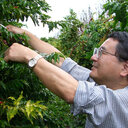Comparative studies on pyrimidine metabolism in excised cotyledons of Pinus radiata during shoot formation in vitro.
Kľúčové slová
Abstrakt
Changes in the pattern of pyrimidine nucleotide metabolism were investigated in Pinus radiata cotyledons cultured under shoot-forming (SF; +N(6)-benzyladenine) and non-shoot-forming (NSF, -N(6)-benzyladenine) conditions, as well as in cotyledons unresponsive (OLD) to N(6)-benzyladenine. This was carried out by following the metabolic fate of externally supplied (14)C-labeled orotic acid, intermediate of the de novo pathway, and (14)C-labeled uridine and uracil, substrates of the salvage pathway. Nucleic acid synthesis was also investigated by following the metabolic fate of (14)C-labeled thymidine during shoot bud formation and development. The de novo synthesis of pyrimidine nucleotides was operative under both SF and NSF conditions, and the activity of orotate phosphoribosyltransferase (OPRT), a key enzyme of the de novo pathway, was higher in SF tissue. Utilization of both uridine and uracil for nucleotide and nucleic acid synthesis clearly indicated that the salvage pathway of pyrimidine metabolism is also operative during shoot organogenesis. In general, uridine was a better substrate for the synthesis of salvage products than uracil, possibly due to the higher activity of uridine kinase (UK), compared to uracil phosphoribosyltransferase (UPRT). Incorporation of uridine into the nucleic acid fraction of OLD cotyledons was lower than that observed for their responsive (day 0) counterparts. Similarly, uracil utilization for nucleic acid synthesis was lower in NSF cotyledons, compared to that observed for SF tissue after 10 days in culture. This difference was ascribed to higher UPRT activity measured in the latter. Thus, there was an apparent difference in the utilization of nucleotides derived from uracil and uridine for nucleotide synthesis. The increased ability to produce pyrimidine nucleotides via the salvage pathway during shoot bud formation may be required in support of nucleic acid synthesis occurring during the process. Studies on thymidine metabolism confirmed this notion.


